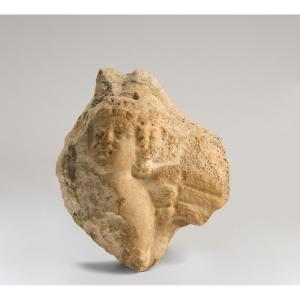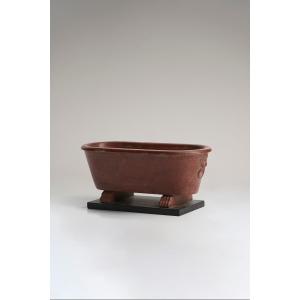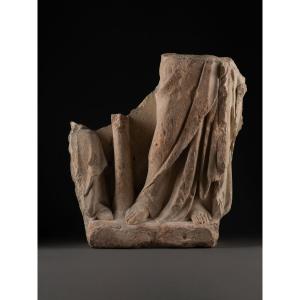Very fine antique sculpture in red porphyry, representing an unidentified Roman emperor, according to the classical canons of Roman statuary.
The depicted figure is reminiscent of emperors such as Hadrian or Marcus Aurelius, although the exact identity of the figure remains open to interpretation. He wears a solemn expression, underlined by a finely bearded face, hair worked in short, regular locks, and a gaze that is both serene and authoritative. The tunic and paludamentum are harmoniously draped over the shoulders, with a keen sense of relief and detail.
The imperial porphyry – a deep red material studded with white crystals – comes exclusively from the Mons Porphyrites quarry in Egypt, exploited since the Roman era under Domitian. Extremely hard, this volcanic rock could only be worked by the most experienced craftsmen, at the cost of considerable labor. It is precisely this rarity, combined with its color evoking blood and purple – a symbol of sovereignty – that made porphyry a material reserved for representations of emperors, imperial sarcophagi, or architectural elements of palaces and sacred buildings. Since the quarry was exhausted in the 5th century AD, all porphyry objects made after Antiquity – notably in Byzantium, during the Renaissance or in the Napoleonic era – necessarily come from blocks extracted during the Roman era, recovered and reused over the centuries.
This bust is part of the tradition of Grand Tour souvenirs, the long initiatory journey undertaken from the 17th to the 19th century by young European aristocrats, mainly British, through France, Italy and Greece. The Grand Tour aimed to perfect their humanist education by discovering the masterpieces of Antiquity, the Renaissance, and the Enlightenment. Many travelers brought back antiquities, casts, or copies, building scholarly collections that adorned libraries and salons. This bust testifies the Group Tour neoclassical taste and the interest in Roman civilization.






























 Le Magazine de PROANTIC
Le Magazine de PROANTIC TRÉSORS Magazine
TRÉSORS Magazine Rivista Artiquariato
Rivista Artiquariato